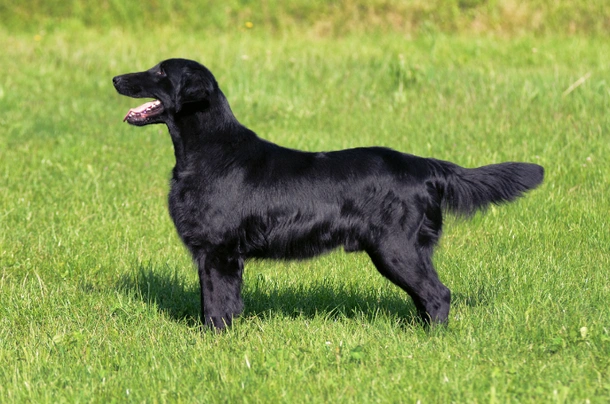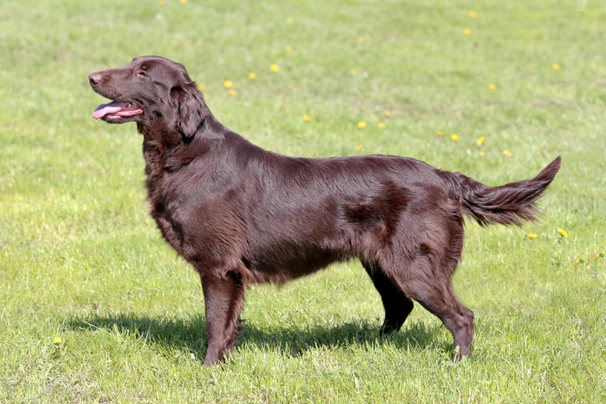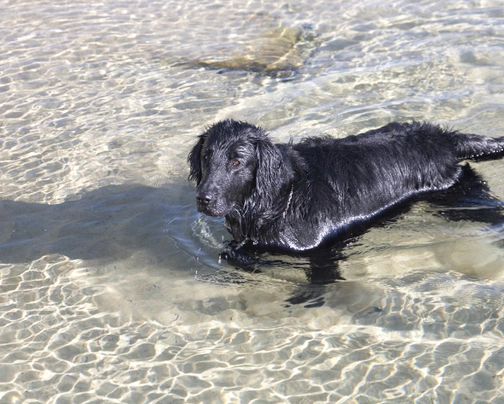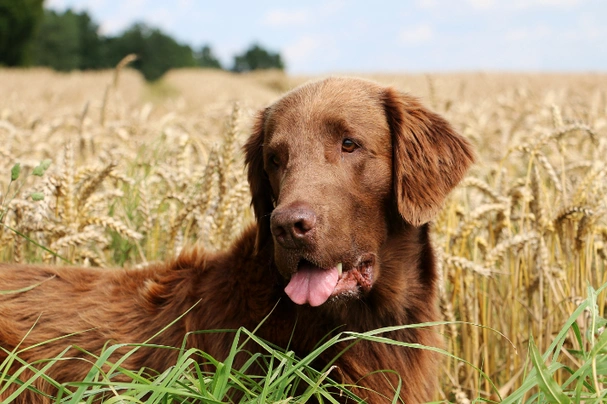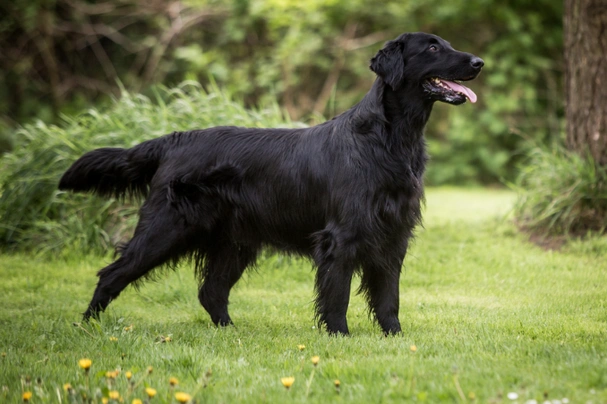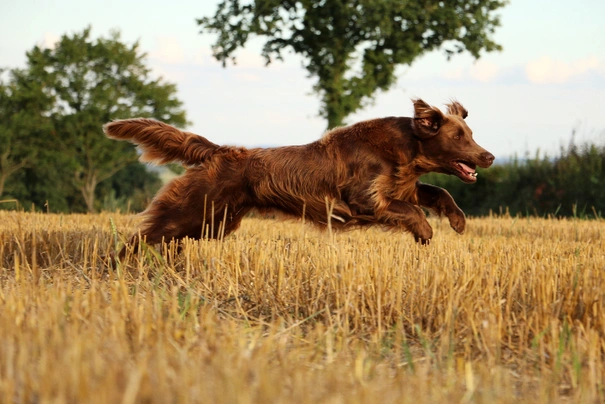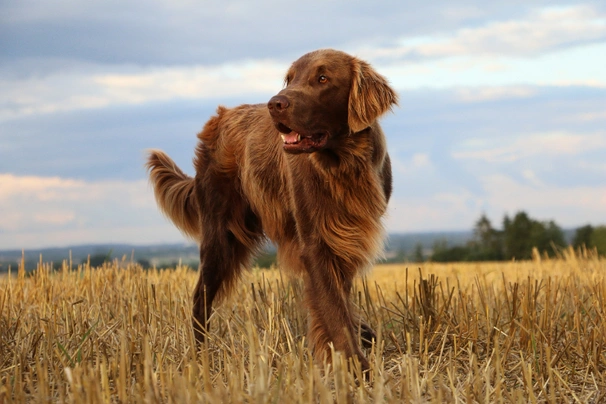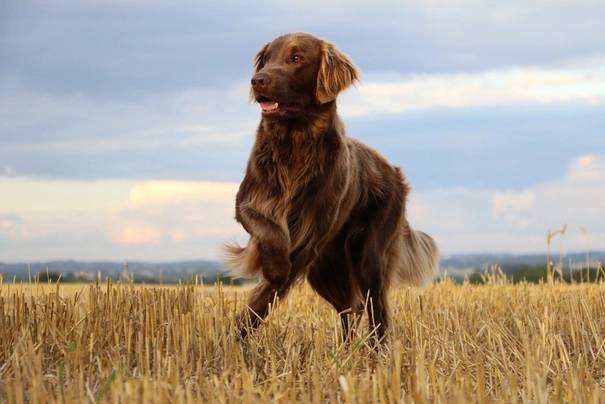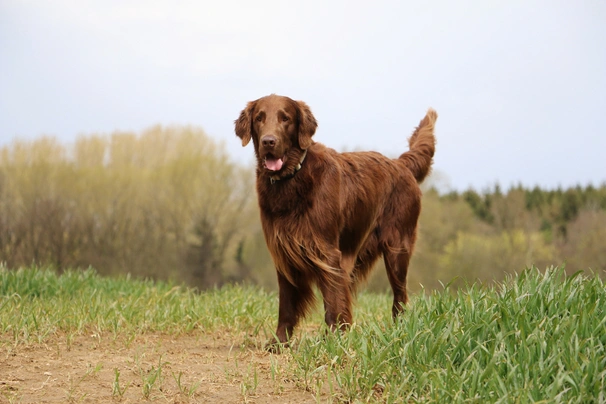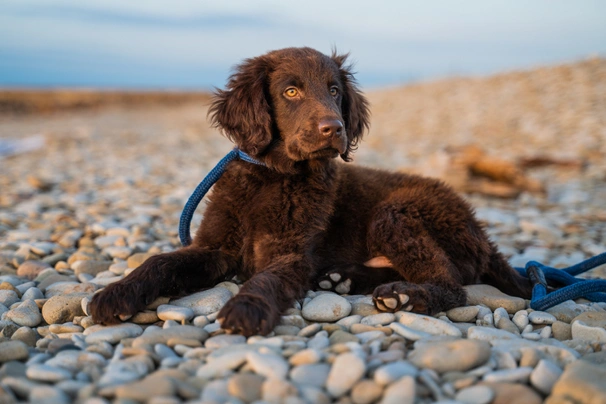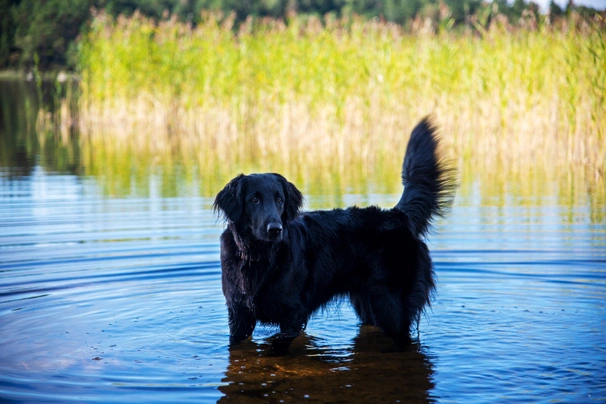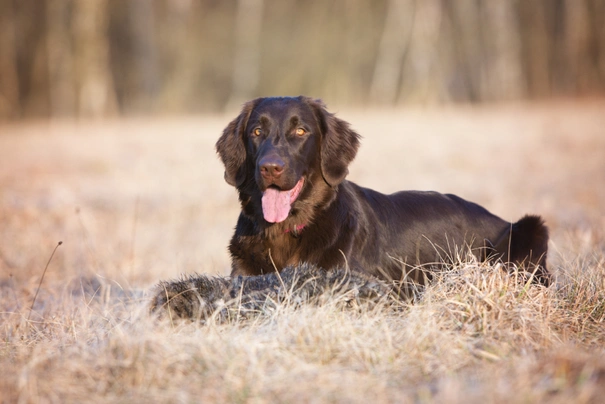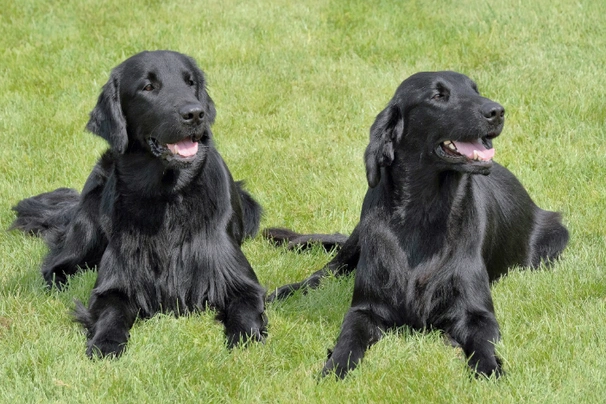Flat coated Retriever
Pros
Cons
Introduction of the Flat coated Retriever
The Flat Coated Retriever is often affectionately referred to as a Flattie. They are large gundogs that resemble Golden and Labrador Retrievers but with longer muzzles which sets them apart from the other two breeds. They love being in and around water and will naturally gravitate towards it whenever they get the chance. They are slow to mature which should be taken into account when training them but this also means they retain their puppy-like traits for that much longer than other dog breeds.
Flatties are known for their energy and stamina often being extremely excitable to boot which is why they are such fun dogs to have around. Flat Coated Retrievers are best suited to people who lead active outdoor lives and who would enjoy the company of an alert agile and extremely energetic smart canine companion at their side.
History of the Flat coated Retriever
There are those who believe the Flat Coated Retriever was developed over 200 years and that Newfoundlands and St. Johns Water Dogs could be in the breed's ancestry. It is thought that dogs that Canadian fishermen and traders took with them to Britain were eventually crossed with native collie breeds with an end goal being to create working and hunting dogs that boasted more stamina and strength. Irish Red Setters were introduced into the mix for their strong scenting skills adding more versatility to the breed.
A man called Mr. J Hull is credited for establishing the breed when he first established a breeding programme in 1864 and soon Flatties became a common sight on larger shooting estates located throughout the country. Another big fan of the breed was a gentleman named Mr. Shirley who also founded the Kennel Club. The first Flat Coated Retriever to be shown in Britain was in the mid 1800's and during the following decades the breed enjoyed a tremendous amount of success more especially in the field.
However with the onset of World War I things slowed down. Breed numbers fell dangerously low during and after World War II which nearly led to these handsome dogs vanishing altogether more especially as other breeds were finding favour with the hunting fraternity.
Although these handsome dogs were promoted by breed enthusiasts during the late 19th century the Flattie never became as popular as their Golden Retriever cousins. The upside of this was that the breed remained much "purer" both as a working dog and as a companion. As previously mentioned Mr. Sewallis Evelyn Shirley the founder of The Kennel Club worked hard to establish a breed type. His efforts and those of other breed enthusiasts produced the Flat Coated Retrievers that we see today.
By the mid-sixties breed numbers were still low but slowly their popularity began to rise with more people becoming familiar with these charming handsome and hardworking dogs. Today although still not as popular as other native retriever breeds the number of Flat Coated Retriever puppies being bred and registered with The Kennel Club continues to rise.
Interesting facts about the breed
- Is the Flat Coated Retriever a vulnerable breed? No they are among some of the more popular dogs in the UK
- The breed is renowned for being excellent "hunting" dogs and are very frequently seen working in the field retrieving game for their handlers
- They were once known as "Wavy-Coated Retrievers" and "Curly-Coated Retrievers"
- One of the breed's biggest fans was the founder of the Kennel Club M Shirley
- Their coats offer Flatties a lot of protection from the elements
- The Flatties defining feature is the lovely shape of their head
- Flatties excel at many canine sports which includes agility obedience and tracking
Appearance of the Flat coated Retriever
Height at the withers: Males 58 - 61 cm Females 56 - 58 cm
Average weight: Males 27 - 36 kg Females 25 - 32 kg
The Flat Coated Retriever is a lean athletic looking dog and one that is super energetic. They have lovely dense coats that lie close and which have a glorious natural sheen. Their heads are nicely moulded and long with skulls being flat and quite broad. There's a slight stop between a dog's eyes. Noses are a nice size with wide open nostrils and dogs have a strong jaw which allows them to carry game easily. Their eyes can either be hazel or dark brown in colour and moderately large with dogs always having an intelligent alert look in them.
Their ears are set well and small lying close to a dog's head. The Flattie has a strong jaw with a perfect scissor bite where their upper teeth neatly overlap their lower ones. Their heads are nicely set in a dog's neck which is quite long and clean. Chests are deep and quite broad with Flatties having a nicely defined brisket and their front legs are straight showing a good amount of bone.
A Flattie has an athletic looking body with their foreribs being quite flat but nicely arched in the middle before getting lighter towards a dog's quarters. Their loins are square and short. Hind legs are well developed and muscular allowing a dog to stand square. Their feet are round with well arched close toes and strong tick pads. Tails are short and straight being well set and which dogs carry very gaily when alert or excited.
When it comes to their coat the Flat Coated Retriever has a dense fine coat that lies as close to the body as possible. Their tails and legs are extremely well feathered which adds to their graceful athletic appearance. The only 2 accepted breed colours for Kennel Club registration are as follows:
- Black
- Liver
Gait/movement
When a Flat Coated Retriever moves they do so with a free-flowing action always true and straight when seen from the front and behind.
Faults
The Kennel Club frowns on any exaggerations or departures from the breed standard and would judge the faults on how much they affect a dog's overall health and wellbeing as well as their ability to perform.
Males should have both testicles fully descended into their scrotums and it is worth noting that a dog can be a little lighter or heavier as well as slightly taller or shorter than set out in the Kennel Club breed standard which is given as a guideline only.
Temperament of the Flat coated Retriever
Flatties mature slowly which in short means they retain their puppy-like characters for that much longer than many other breeds. They are alert active dogs that need to be kept busy and they enjoy being out and about as much as possible. They are highly intelligent which means in the right hands and environment Flatties are easy to train. They are very outgoing confident characters that boast kind placid natures although they are extremely fun-loving dogs too.
Having been originally bred as working dogs the Flattie remains very much a "working" dog even in a home environment. As such they are best suited to families who lead active outdoor lives and where one person usually stays at home when everyone else is out of the house. They do not do well if they are left on their own for longer periods of time and if they are a Flattie will do everything in their power to escape out of a home. In short they would quickly get bored and this can lead to them developing some very destructive behaviours around the home.
They are often referred to as the "gamekeeper's dog" and are never happier than when they live in a country environment. These dogs need enough space to express themselves as they should and this means lots of indoor and outdoor space. They are often referred to as the canine world's "Peter Pan" thanks to their lively excitable and puppy-like traits which they retain even into their golden years.
Flatties are a great choice for first time owners because they are so intelligent and quick to learn new things. However they are extremely high maintenance on the exercise front and need to be given a ton of mental stimulation every single day for them to be truly happy well-rounded dogs. In short new owners need to have the right amount of time to dedicate to their canine companion.
Are they a good choice for first time owners?
Flatties are a good choice for first time dog owners providing they have the time to dedicate to an active energetic and intelligent canine companion that thrives on human company. They are better suited to households where one person stays at home so they never spend too much time on their own.
What about prey drive?
Flatcoats are very social by nature but they have working and retrieving in their blood. As such they love nothing more than to chase things which includes wild animals and anything that tries to run away which includes the neighbour's cat. As such care should always be taken as to where and when a dog can run off the lead more especially when they are around livestock.
What about playfulness?
Flatties have a very playful side to their natures and love to entertain and be entertained. They are known to be a little mischievous when the mood takes them and being so clever they quickly learn what pleases an owner. It is best to teach a Flattie puppy that playtime takes place outside to avoid any breakages in the house because things can get a bit boisterous bearing in mind that the breed matures slowly. As such they retain many of their puppy traits well into their senior years.
What about adaptability?
Flat Coated Retrievers are better suited to people who have large secure back gardens that a dog can safely roam in whenever possible. They are not well suited to apartment living because they are high energy dogs that need a ton of daily physical exercise and mental stimulation to be truly well-rounded happy dogs.
What about separation anxiety?
Flatcoats form strong ties with their families and dogs are never very happy when they find themselves left on their own for longer periods of time. They are better suited to people who either work from home or in households where one person stays at home when everyone else is out so they are never alone for any length of time which could see a dog suffering from separation anxiety. This can lead to them being destructive around the home which is a dog's way of relieving any stress they are feeling and a way to keep themselves entertained and this could include incessant barking to get attention.
What about excessive barking?
Some Flatties like the sound of their own voices a little too much which is something that needs to be gently nipped in the bud when a dog is still young being careful not to frighten them bearing in mind that they are quite sensitive dogs by nature. Others will only bark when there are strangers about or when something they don't like is going on in their surroundings.
Do Flat Coated Retrievers like water?
Flatties love swimming and will take to the water whenever they can at any time of the year. With this said care should always be taken when walking a Flat Coated Retriever off the lead anywhere near more dangerous watercourses just in case a dog decides to leap in and then needs rescuing because they cannot get out of the water on their own. It is important to thoroughly dry a dog off when they get wet paying special attention to their ears.
Are Flat Coated Retrievers good watchdogs?
Flatties are not natural watchdogs although this is not to say a dog would not be quick off the mark to let an owner know when there are strangers about although they would rarely do this aggressively preferring to keep their distance and bark.
Intelligence / Trainability of the Flat coated Retriever
Flatties are highly intelligent dogs and they pick things up quickly. This paired to the fact they love to please makes them easy to train. However the downside is that they learn the bad things just as quickly. In the right hands and environment they are a delight to train because they are so receptive. However they can be a little wilful at times which means they need to be handled with a firm yet gentle hand to get the best out them. They can also be a bit "naughty" thanks to the fact they mature so slowly so it's important never to rush a Flattie's training but to give them the time they need to really grow up.
Like many other breeds the Flattie is a sensitive dog and therefore they do not respond well to any sort of harsh correction or heavier handed training methods. They do answer extremely well to positive reinforcement which always brings the best out of these dogs. They are never happier than when they know what an owner expects of them and who they can look to for direction and guidance. As such it's important for a Flattie's training to be consistent and always fair.
Flat Coated Retriever puppies are very cute and they are intelligent although sensitive too. As such it is often too easy to spoil a puppy when they first arrive in their new home which can lead to a dog developing some behavioural issues. Owners need to start out as they mean to go on which means laying down the limits and boundaries from the word go so that a puppy understands what is acceptable behaviour and what is not. All dogs are much happier when they know what their owners expect of them although they will test the "rules" from time to time to see how much they can get away with. The first commands a Flattie puppy should be taught are as follows:
- Come
- Sit
- Stay
- Quiet
- Leave it
- Down
- Bed
Children and other
Flat Coated Retrievers have earned themselves an excellent reputation for being a good choice as family pets because they get on extremely well with children. However they can be a little excitable and over enthusiastic during playtime. As such any interaction between the kids and a dog should be supervised by an adult to make sure things don't get too boisterous. With this said they are a great choice for families where the children a slightly older and therefore know how to behave around dogs rather in households where the kids are that much younger.
When well socialised from a young age the Flattie generally gets on well with other dogs. If they have grown up with a family cat in the home they usually get on well together too. However a Flattie would think nothing of chasing any other cats they come across. Care needs to be taken when they are around any other smaller animals and pets just in case a dog's high prey drive gets the better of them.
Health of the Flat coated Retriever
The average life expectancy of a Flattie is between 8 and 10 years when properly cared for and fed an appropriate good quality diet to suit their ages.
Like so many other breeds the Flat Coated Retriever is known to suffer from a few hereditary health issues which are worth knowing about if you are planning share your home with one of these active and good-looking dogs. The conditions that seem to affect the breed the most include the following:
- Patellar luxation - dogs should be screened
- Hip dysplasia - dogs should be hip scored through the BVA/KC scheme
- Elbow dysplasia - dogs should be tested under the BVA scheme
- Primary Glaucoma - test available through the BVA scheme
- Cardiomyopathy
- Cranial Cruciate Ligament Failure
- Osteoarthritis
- Ophthalmic conditions (Adnexa)
- Laryngeal Paralysis
- Alabama rot
- Renal Dysplasia
- Cancer
- Ear issues
- Bloat
What about vaccinations?
Flatcoat puppies would have been given their initial vaccinations before being sold but it is up to their new owners to make sure they have their follow-up shots in a timely manner with the vaccination schedule for puppies being as follows:
- 10 -12 weeks old bearing in mind that a puppy would not have full protection straight away but would be fully protected 2 weeks after they have had their second vaccination
There has been a lot of discussion about the need for dogs to have boosters. As such it's best to talk to a vet before making a final decision on whether a dog should continue to have annual vaccinations which are known as boosters.
What about spaying and neutering?
A lot of vets these days recommend waiting until dogs are slightly older before spaying and neutering them which means they are more mature before undergoing the procedures. As such they advise neutering males and spaying females when they are between the ages of 6 to 9 months old and sometimes even when a dog is 12 months old.
Other vets recommend spaying and neutering dogs when they are 6 months old but never any earlier unless for medical reasons. With this said many breeds are different and it is always advisable to discuss things with a vet and then follow their advice on when a dog should be spayed or neutered.
What about obesity problems?
Some Flatties gain weight after they have been spayed or neutered and it's important to keep an eye on a dog's waistline just in case they do. If a dog starts to put on weight it's important to adjust their daily calorie intake and to up the amount of exercise they are given. Older dogs too are more prone to gaining weight and again it's essential they be fed and exercised accordingly because obesity can shorten a dog's life by several years. The reason being that it puts a lot of extra strain on a dog's internal organs including the heart which could prove fatal.
What about allergies?
Some Flatties are prone to suffering from allergies more especially as they like to be in water and it's important for a dog to see a vet sooner rather than later if one flares up. It is also essential to thoroughly dry off a dog's coat to prevent a skin issue from developing. Allergies can be notoriously hard to clear up and finding the triggers can be challenging. With this said a vet would be able to make a dog with an allergy more comfortable while they try to find out the triggers which could include the following:
- Certain dog foods that contain high levels of cereal and other grain fillers
- Airborne pollens
- Dust mites
- Environment
- Flea and tick bites
- Chemicals found in everyday household cleaning products
Participating in health schemes
All responsible Flat Coated Retriever breeders would ensure that their stud dogs are tested for known hereditary and congenital health issues known to affect the breed by using the following schemes:
- Patellar luxation - dogs should be screened
- Hip dysplasia - dogs should be hip scored through the BVA/KC scheme
- Elbow dysplasia - dogs should be tested under the BVA scheme
- Primary Glaucoma - test available through the BVA scheme
What about breed specific breeding restrictions?
Apart from the standard Kennel Club breeding restrictions for all Kennel Club registered dogs there are no other breed specific breeding restrictions in place for the Flat Coated Retriever.
What about Assured Breeder Requirements?
It is mandatory for all Kennel Club Assured Breeders to use the following schemes and the Kennel Club strongly advises that all other breeders follow suit:
The Kennel Club also strongly recommends that all breeders use the following schemes on all breeding dogs:
- Eye testing
- Bitches are not to produce a litter when they are under 2 years old
- Bitches are not to produce more than 3 litters during their lifetimes
- Bitches are not to produce more than one litter in any 12-month period
Caring for the Flat coated Retriever
As with any other breed Flatties need to be groomed on a regular basis to make sure their coats and skin are kept in top condition. They also need to be given regular daily exercise to ensure they remain fit and healthy. On top of this dogs need to be fed good quality food that meets all their nutritional needs throughout their lives.
Caring for a Flat Coated Retriever puppy
Flatcoat puppies are boisterous and full of life which means it's essential for homes and gardens to be puppy-proofed well in advance of their arrival. A responsible breeder would have well socialised their puppies which always leads to more outgoing confident and friendly dogs right from the word go. With this said any puppy is going to feel vulnerable when they leave their mother and littermates which must be taken into account. The longer a puppy can remain with their mother the better although it should never be for too long either.
It's best to pick a puppy up when people are going to be around for the first week or so which is the time needed for a puppy to settle in. Puppy-proofing the home and garden means putting away any tools and other implements that a boisterous puppy might injure themselves on. Electric wires and cables must be put out of their reach because puppies love chewing on things. Toxic plants should be removed from flowerbeds and the home too.
Puppies need to sleep a lot to grow and develop as they should which means setting up a quiet area that's not too out of the way means they can retreat to it when they want to nap and it's important not to disturb them when they are sleeping. It's also a good idea to keep "playtime" nice and calm inside the house and to have a more active "playtime" outside in the garden which means puppies quickly learn to be less boisterous when they are inside.
The documentation a breeder provides for a puppy must have all the details of their worming date and the product used as well as the information relating to their microchip. It is essential for puppies to be wormed again keeping to a schedule which is as follows:
- Puppies should be wormed at 6 months old
- They need to be wormed again when they are 8 months old
- Puppies should be wormed when they are 10 months old
- They need to be wormed when they are 12 months old
Things you'll need for your puppy
There are certain items that new owners need to already have in the home prior to bringing a new puppy home. It's often a good idea to restrict how much space a puppy plays in more especially when you can't keep an eye on what they get up to bearing in mind that puppies are often quite boisterous which means investing in puppy gates or a large enough playpen that allows a puppy the room to express themselves while keeping them safe too. The items needed are therefore as follows:
- Good quality puppy or baby gates to fit on doors
- A good well-made playpen that's large enough for a puppy to play in so they can really express themselves as puppies like to do
- Lots of well-made toys which must include good quality chews suitable for puppies to gnaw on bearing in mind that a puppy will start teething anything from when they are 3 to 8 months old
- Good quality feed and water bowls which ideally should be ceramic rather than plastic or metal
- A grooming glove
- A slicker brush or soft bristle brush
- Dog specific toothpaste and a toothbrush
- Scissors with rounded ends
- Nail clippers
- Puppy shampoo and conditioner which must be specifically formulated for use on dogs
- A well-made dog collar or harness
- A couple of strong dog leads
- A well-made dog bed that's not too small or too big
- A well-made dog crate for use in the car and in the home that's large enough for a puppy to move around in
- Baby blankets to put in your puppy's crate and in their beds for when they want to nap or go to sleep at night
Keeping the noise down
All puppies are sensitive to noise including Flatcoat puppies. It's important to keep the noise levels down when a new puppy arrives in the home. TVs and music should not be played too loud which could end up stressing a small puppy out.
Keeping vet appointments
As previously mentioned Flattie puppies would have been given their first vaccinations by the breeders but they must have their follow up shots which is up to their new owners to organise. The vaccination schedule for puppies is as follows:
- 10 -12 weeks old bearing in mind that a puppy would not have full protection straight away but would only be fully protected 2 weeks after they have had their second vaccination
When it comes to boosters it's best to discuss these with a vet because there is a lot of debate about whether a dog really needs them after a certain time. However if a dog ever needed to go into kennels their vaccinations would need to be fully up to date.
What about older Flat Coated Retrievers when they reach their senior years?
Older Flatcoats need lots of special care because as they reach their golden years they are more at risk of developing certain health concerns. Physically a dog's muzzle may start to go grey but there will be other noticeable changes too which includes the following:
- Coats become coarser
- A loss of muscle tone
- Flatties can either become overweight or underweight
- They have reduced strength and stamina
- Older dogs have difficulty regulating their body temperature
- They often develop arthritis
- Immune systems do not work as efficiently as they once did which means dogs are more susceptible to infections
Older dogs change mentally too which means their response time tends to be slower as such they develop the following:
- They respond less to external stimuli due to impaired vision or hearing
- They tend to be a little pickier about their food
- They have a lower pain threshold
- Become intolerant of any change
- Often an older dog can feel disorientated
Living with a Flat Coated Retriever in their golden years means taking on a few more responsibilities but these are easily managed and should include looking at their diet the amount of exercise they are given how often their dog beds need changing and keeping an eye on the condition of their teeth.
Older Flat Coated Retrievers need to be fed a good quality diet that meets their needs at this stage of their lives all the while keeping a close eye on a dog's weight. A rough feeding guide for older Flatcoats is as follows bearing in mind they should be fed highly digestible food that does not contain any additives:
- Protein content should be anything from 14 – 21%
- Fat content should be less than 10%
- Fibre content should be less than 4%
- Calcium content should be 0.5 – 0.8%
- Phosphorous content should be 0.4 – 0.7%
- Sodium content should be 0.2 – 0.4%
Older Flatties don't need to be given the same amount of daily exercise as a younger dog but they still need the right amount of physical activity to maintain muscle tone and to prevent a dog from putting on too much weight. All dogs need access to fresh clean water and this is especially true of older dogs when they reach their golden years because they are more at risk of developing kidney disorders.
Grooming of the Flat coated Retriever
Flatties have medium to long coats and ideally they need to be brushed every day to prevent any matts and tangles from forming. Particular attention must be paid to a dog's ears and their underbellies as well as the feathering on their legs where the hair tends to be that much finer and therefore more prone to getting tangled. Flatties shed throughout the year only more so during the Spring and then again in the Autumn when more frequent grooming is usually necessary to keep on top of things and to remove any dead and loose hair from a dog's coat.
Because Flatties love being in and around water they tend to pick up quite a bit of mud and debris in the coats too. It's important for dogs to be thoroughly dried off once they get home paying special attention to a dog's ears more especially as Flatties are so prone to developing ear infections. Flatties also benefit from being taken to be professionally groomed several times a year which makes keeping things tidy that much easier in between visits to a grooming parlour. A professional groomer would also be able to thin out a dog's feathers if they get too thick and long.
It's also important to check a dog's ears on a regular basis and to clean them when necessary. If too much wax builds up in a dog's ears it can lead to a painful infection which can be hard to clear up. In short prevention is often easier than cure when it comes to ear infections.
Exercise of the Flat coated Retriever
Flatties are high energy intelligent dogs which means they need to be given the right amount of daily exercise and enough mental stimulation to be truly happy well-rounded dogs. They need to be given at least 2 hours a day and more if possible. The more exercise a Flattie gets the happier they are because they are literally tireless dogs that are always ready and willing to be out and about with their owners.
They are naturally strong swimmers and enjoy being taken where it is safe for them to jump in the water for a dip. If they are not given the right amount of mental stimulation and exercise every day a Flattie would quickly get bored and could even begin to show some destructive behaviours around the home which includes trying to break their way out which could result in them injuring themselves in the process.
A shorter walk in the morning would be fine but a longer more interesting one in the afternoon is a must. These dogs also like to be able to roam around a back garden as often as possible so they can really let off steam. However the fencing must be extremely secure to keep these high energy dogs in because if they find a weakness in the fence they will soon escape out and get into all sorts of trouble.
With this said Flattie puppies should not be over exercised because their joints and bones are still growing. This includes not letting a dog jump up and down from furniture or going up or down the stairs. Too much pressure placed on their joints and spines at an early age could result in a dog developing serious problems later in their lives.
Feeding of the Flat coated Retriever
If you get a Flattie puppy from a breeder they would give you a feeding schedule and it's important to stick to the same routine feeding the same puppy food to avoid any tummy upsets. You can change a puppy's diet but this needs to be done very gradually always making sure they don't develop any digestive upsets and if they do it's best to put them back on their original diet and to discuss things with the vet before attempting to change it again.
Older dogs are not known to be fussy or finicky eaters but this does not mean you can feed them a lower quality diet. It's best to feed a mature dog twice a day once in the morning and then again in the evening making sure it's good quality food that meets all their nutritional requirements. It's also important that dogs be given the right amount of exercise so they burn off any excess calories or they might gain too much weight which can lead to all sorts of health issues. Obesity can shorten a dog's life by several years so it's important to keep an eye on their waistline from the word go.
Because Flatties are known to suffer from bloat it is important for them to be fed twice a day instead of giving a dog just one larger meal a day. It's also a good idea to invest in a stand for their feed bowls which makes it easier for these large dogs to eat comfortably without having to stretch their necks down to reach their food. Dogs should never be exercised just before or just after they have eaten either because this puts them more at risk of suffering from gastric torsion.
Feeding guide for a Flat Coated Retriever puppy
Puppies need to be fed a highly nutritious good quality diet for them to develop and grow as they should. As a rough guide a Flat Coated Retriever puppy can be fed the following amounts every day making sure their meals are evenly spread out throughout the day and it's best to feed them 3 or 4 times a day:
- 2 months old - 264g to 286g depending on puppy's build
- 3 months old - 327g to 365g depending on puppy's build
- 4 months old - 354g to 400g depending on puppy's build
- 5 months old - 381g to 454g depending on puppy's build
- 6 months old - 405g to 505g depending on puppy's build
- 7 months old - 403g to 506g depending on puppy's build
- 8 months old - 374g to 471g depending on puppy's build
- 9 months old - 349g to 440g depending on puppy's build
- 10 months old - 318g to 402g depending on puppy's build
- 11 months old - 290g to 385g depending on puppy's build
- 12 months old - 288g to 363g depending on puppy's build
- 13 months old - 286g to 360g depending on puppy's build
- 14 months old - 286g to 357g depending on puppy's build
Once a puppy is 15 months old they can be fed adult dog food.
Feeding guide for an adult Flat Coated Retriever
Once fully mature an adult Flat Coated Retriever must be fed a good quality diet to ensure their continued good health. As a rough guide an adult Flat Coated Retriever can be fed the following amounts every day bearing in mind that they are known to suffer from bloat so it's important not to feed them directly after having been exercised or just before they are due to go out for a walk. It is also best to feed smaller amounts several times a day rather than just one or two larger meals:
- Dogs weighing 25 kg can be fed 276g to 363g depending on activity
- Dogs weighing 27 kg can be fed 291g to 383g depending on activity
- Dogs weighing 32 kg can be fed 322g to 424g depending on activity
- Dogs weighing 36 kg can be fed 352g to 363g depending on activity
Flat coated Retriever price
If you are looking to buy a Flat Coated Retriever you would need to pay anything from £700 to over £800 for a well-bred pedigree puppy. The cost of insuring a male 3-year-old Flattie in northern England would be £22.21 a month for basic cover but for a lifetime policy this would set you back £51.37 a month (quote as of December 2017). When insurance companies calculate a pet's premium they factor in several things which includes where you live in the UK a dog's age and whether they have been neutered or spayed among other things.
When it comes to food costs you need to buy the best quality food whether wet or dry making sure it suits the different stages of a dog’s life. This would set you back between £50 - £60 a month. On top of this you need to factor in veterinary costs if you want to share your home with a Flat Coated Retriever and this includes their initial vaccinations their annual boosters the cost of neutering or spaying a dog when the time is right and their yearly health checks all of which quickly adds up to over £1000 a year.
As a rough guide the average cost to keep and care for a Flat Coated Retriever would be between £80 to £120 a month depending on the level of insurance cover you opt to buy for your dog but this does not include the initial cost of buying a healthy well-bred Kennel Club registered pedigree Flat Coated Retriever puppy.
Buying advice
When visiting and buying any puppy or dog there are many important things to consider and questions to ask of the breeder/seller. You can read our generic puppy/dog advice here which includes making sure you see the puppy with its mother and to verify that the dog has been wormed and microchipped.
Flat Coated Retrievers are a popular breed both in the UK and elsewhere in the world which means that healthy well-bred puppies can often command a lot of money. As such with Flat Coats there is specific advice questions and protocols to follow when buying a puppy which are as follows:
- Beware of online scams and how to avoid them. You may see online and other adverts by scammers showing images of beautiful Flat Coated Retrieverpuppies for sale at very low prices. However the sellers ask buyers for money up front before agreeing to deliver a puppy to a new home. Potential buyers should never buy a puppy unseen and should never pay a deposit or any other money online to a seller. You should always visit the pet at the sellers home to confirm they are genuine and make a note of their address.
- As previously touched upon Flat Coated Retrievers have fast become one of the more popular breeds in the UK. As such there are many amateur breeders/people who breed from a dam far too often so they can make a quick profit without caring for the welfare of the puppies their dam or the breed in general. Under Kennel Club rules a dam can only produce 4 litters and she must be between a certain age to do so. Anyone wishing to buy a Flat Coated Retriever very carefully about who they purchase their puppy from and should always ask to see the relevant paperwork pertaining to a puppy's lineage their vaccinations and their microchipping.
- Prospective owners should be very careful when considering buying a Flat Coated Retriever from abroad and should refer to the "Health Testing" information for Imported Dogs before committing to buy a dog. The information can be found at the Flat Coated Retriever Breed Club UK website under Point 16 of the "Society's Code of Ethics".
